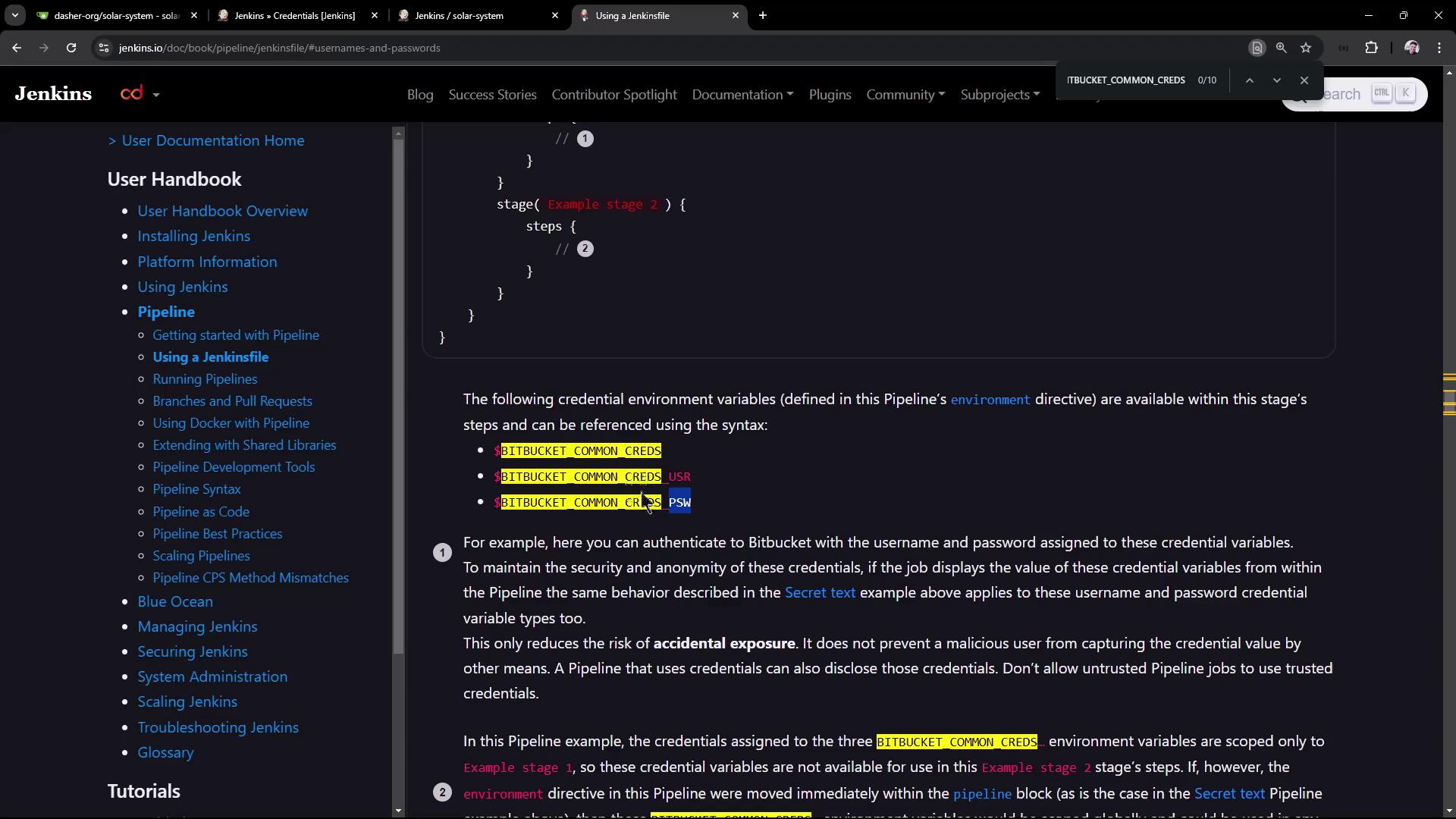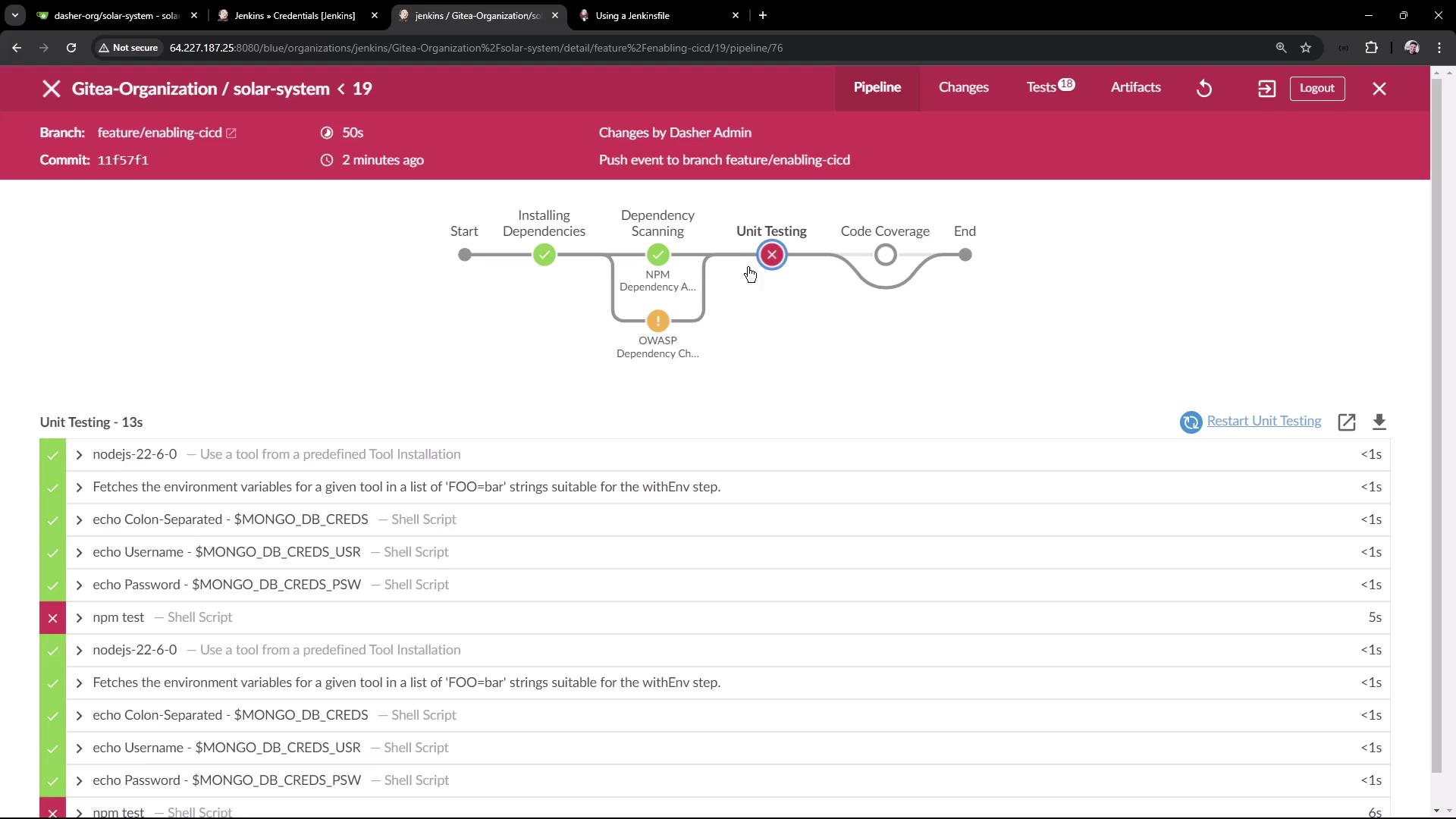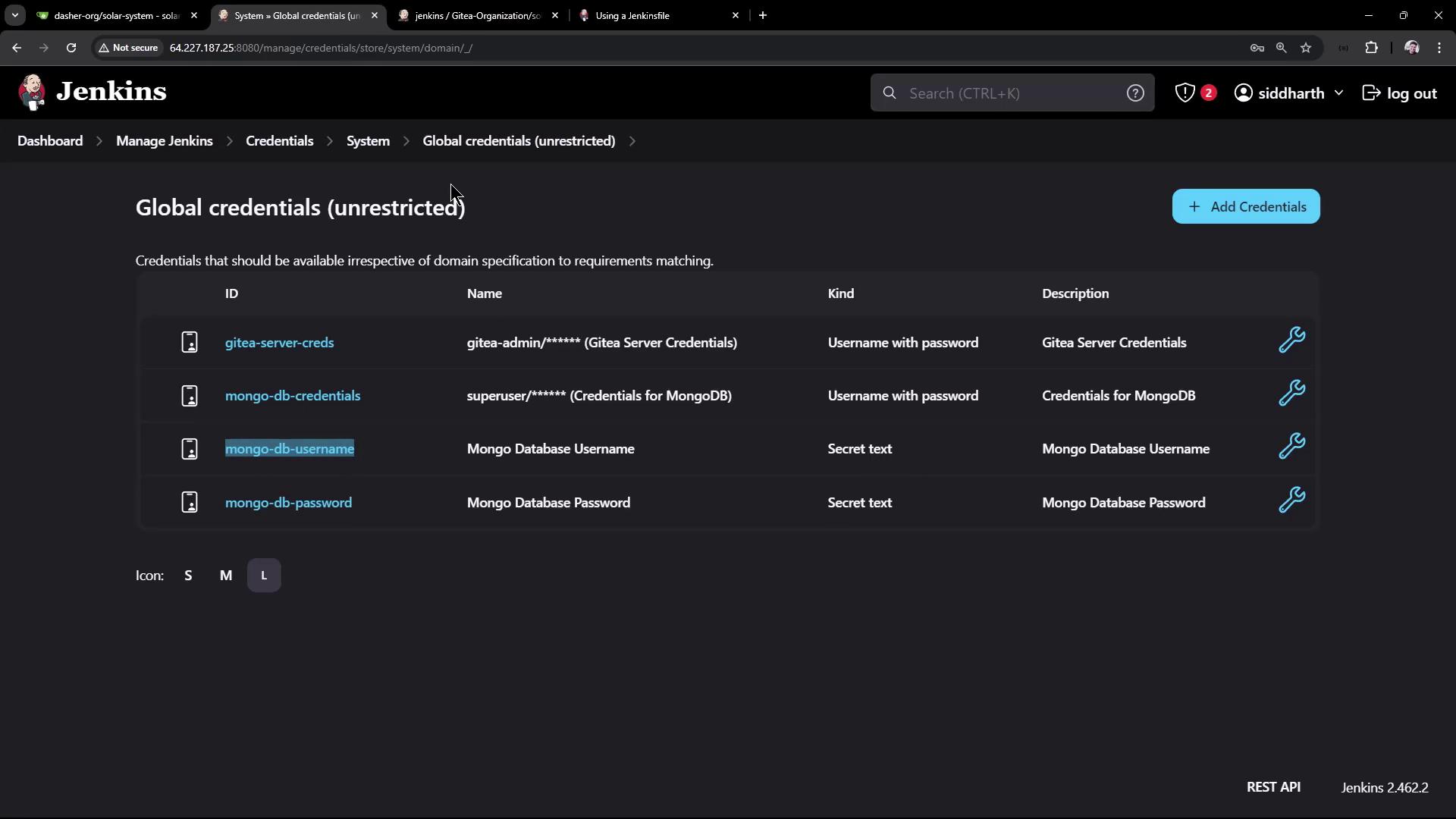Certified Jenkins Engineer
Code Quality and Testing
Demo Refactoring Jenkinsfile
In this guide, we’ll walk through refactoring a Jenkins pipeline to:
- Simplify credential handling
- Remove duplicate
withCredentialsblocks - Centralize test report and HTML publishing in a
postsection
This approach reduces boilerplate and improves maintainability of your Jenkinsfile.
Original Jenkinsfile Snippet
Both the Unit Testing and Code Coverage stages currently use identical withCredentials wrappers:
pipeline {
agent any
environment {
MONGO_URI = "mongodb+srv://supercluster.d83jj.mongodb.net/superData"
}
options {
// ...
}
stages {
stage('Installing Dependencies') { /* ... */ }
stage('Dependency Scanning') { /* ... */ }
stage('Unit Testing') {
options { retry(2) }
steps {
withCredentials([usernamePassword(
credentialsId: 'mongo-db-credentials',
passwordVariable: 'MONGO_PASSWORD',
usernameVariable: 'MONGO_USERNAME'
)]) {
sh 'npm test'
}
}
junit allowEmptyResults: true, testResults: 'test-results.xml'
}
stage('Code Coverage') {
steps {
withCredentials([usernamePassword(
credentialsId: 'mongo-db-credentials',
passwordVariable: 'MONGO_PASSWORD',
usernameVariable: 'MONGO_USERNAME'
)]) {
sh 'npm run coverage'
}
publishHTML(
allowMissing: true,
alwaysLinkToLastBuild: true,
keepAll: true,
reportDir: 'coverage/lcov-report',
reportFiles: 'index.html',
reportName: 'Code Coverage HTML Report'
)
}
}
}
}
root@jenkins-controller-1 in solar-system on ⬢ feature/enabling-cicd via 🐍 v20.16.0
>
1. Injecting Credentials via environment
Instead of wrapping every stage in withCredentials, Jenkins can populate environment variables automatically:
| Environment Variable | Value |
|---|---|
MY_CREDS | username:password |
MY_CREDS_USR | username |
MY_CREDS_PSW | password |

Define a Single Credential
pipeline {
agent any
environment {
MONGO_DB_CREDS = credentials('mongo-db-credentials')
}
stages {
stage('Unit Testing') {
options { retry(2) }
steps {
// No explicit withCredentials needed
sh 'npm test'
}
junit allowEmptyResults: true, testResults: 'test-results.xml'
}
}
}
Note
You can echo these variables to confirm that Jenkins injects them correctly, but remember that secrets remain masked in logs.
stage('Unit Testing') {
options { retry(2) }
steps {
sh 'echo Colon-Separated → $MONGO_DB_CREDS'
sh 'echo Username → $MONGO_DB_CREDS_USR'
sh 'echo Password → $MONGO_DB_CREDS_PSW'
sh 'npm test'
}
junit allowEmptyResults: true, testResults: 'test-results.xml'
}
root@jenkins-controller-1 in solar-system on ⬢ feature/enabling-cid via ⬢ v20.16.0
2. Why the Stage Fails
After pushing, the build fails:

Although the variables are injected:
$MONGO_DB_CREDSis masked$MONGO_DB_CREDS_USRis displayed$MONGO_DB_CREDS_PSWis masked
Your test suite still expects MONGO_USERNAME and MONGO_PASSWORD, so the stage cannot authenticate.
3. Defining Separate Secret-Text Credentials
To match your test code, split the single credential into two Secret text entries:
- In Jenkins UI, go to Credentials > Global.
- Add Secret text credentials:
- ID:
mongo-db-username→ MongoDB username - ID:
mongo-db-password→ MongoDB password
- ID:

- Update the
environmentblock accordingly:
pipeline {
agent any
environment {
MONGO_URI = "mongodb+srv://supercluster.d83jj.mongodb.net/superData"
MONGO_DB_CREDS = credentials('mongo-db-credentials') // optional composite
MONGO_USERNAME = credentials('mongo-db-username')
MONGO_PASSWORD = credentials('mongo-db-password')
}
stages {
stage('Unit Testing') {
options { retry(2) }
steps {
sh 'echo DB Creds → $MONGO_DB_CREDS'
sh 'echo Username → $MONGO_USERNAME'
sh 'echo Password → $MONGO_PASSWORD'
sh 'npm test'
}
junit allowEmptyResults: true, testResults: 'test-results.xml'
}
stage('Code Coverage') {
steps {
catchError(buildResult: 'SUCCESS', stageResult: 'UNSTABLE') {
sh 'npm run coverage'
}
publishHTML(
allowMissing: true,
alwaysLinkToLastBuild: true,
keepAll: true,
reportDir: 'coverage/lcov-report',
reportFiles: 'index.html',
reportName: 'Code Coverage HTML Report'
)
}
}
}
}
4. Centralizing Reports in post { always { ... } }
Rather than repeating junit and publishHTML in each stage, use a post block to archive all reports after every build:
pipeline {
agent any
environment { /* ... */ }
options { /* ... */ }
stages {
stage('Installing Dependencies') { /* ... */ }
stage('Dependency Scanning') { /* ... */ }
stage('OWASP Dependency Check') { /* ... */ }
stage('Unit Testing') { /* ... */ }
stage('Code Coverage') { /* ... */ }
}
post {
always {
junit allowEmptyResults: true, testResults: 'test-results.xml'
junit allowEmptyResults: true, testResults: 'dependency-check-junit.xml'
publishHTML(
allowMissing: true,
alwaysLinkToLastBuild: true,
keepAll: true,
reportDir: 'coverage/lcov-report',
reportFiles: 'index.html',
reportName: 'Code Coverage HTML Report'
)
// Add additional publishHTML calls as needed
}
}
}
Warning
Don’t forget to adjust testResults patterns if you rename or relocate report files—otherwise Jenkins may skip them.
5. Run the Refactored Pipeline
With credentials injected at the top and reports centralized, the build should now succeed:
> npm test
> mocha app-test.js --timeout 10000 --reporter mocha-junit-reporter --exit
Server successfully running on port - 3000
...
> npm run coverage
...
[htmlpublisher] Archiving HTML reports...
...
Final Full Example
pipeline {
agent any
environment {
MONGO_URI = "mongodb+srv://supercluster.d83jj.mongodb.net/superData"
MONGO_DB_CREDS = credentials('mongo-db-credentials')
MONGO_USERNAME = credentials('mongo-db-username')
MONGO_PASSWORD = credentials('mongo-db-password')
}
options {
// ...
}
stages {
stage('Installing Dependencies') { /* ... */ }
stage('Dependency Scanning') { /* ... */ }
stage('Unit Testing') {
options { retry(2) }
steps {
sh 'echo DB Creds → $MONGO_DB_CREDS'
sh 'echo Username → $MONGO_USERNAME'
sh 'echo Password → $MONGO_PASSWORD'
sh 'npm test'
}
}
stage('Code Coverage') {
steps {
catchError(buildResult: 'SUCCESS', stageResult: 'UNSTABLE') {
sh 'npm run coverage'
}
}
}
}
post {
always {
junit allowEmptyResults: true, testResults: 'test-results.xml'
junit allowEmptyResults: true, testResults: 'dependency-check-junit.xml'
publishHTML(
allowMissing: true,
alwaysLinkToLastBuild: true,
keepAll: true,
reportDir: 'coverage/lcov-report',
reportFiles: 'index.html',
reportName: 'Code Coverage HTML Report'
)
// Add other publishHTML steps here
}
}
}
Links and References
- Jenkins Pipeline Syntax: Environment
- Jenkins Credentials Binding Plugin
- Mocha JUnit Reporter
- Jenkins HTML Publisher Plugin
Watch Video
Watch video content